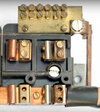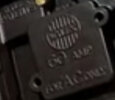It's specified by most manufacturers of MCBs and other devices, and usually referred to as RDF or rated diversity factor. .... In the case of 66%, that would mean a 32A device being only rated to 21A if it was to be fully loaded.
As I implied, that's what I presumed, but it seems to be somewhat contorted, potentially confusing and, in some senses, 'circular' language.
For a start, I'm not sure in what sense it is using the word "diversity". However, I find it somewhat confusing talking about a 32A device being 'fully loaded' at 21A, particularly given that it's operating characteristics (e.g. I
1 and I
2) will still; be defined by its I
n (i.e. 32A) - and that anyone coming across it in the future could perhaps be forgiven for regarding it simply as a "32A device".
What I'm finding particularly confusing (hence my reference to 'circular language') is that 'fully loading" a 32A advice would seem to mean that the load was 32A, yet application of the RDF would not allow it to be loaded beyond 21A - so it's really talking about a circuit that one would
like to 'fully load' to the OPD's I
n), but cannot because of the need to apply an RDF.
The 'load' is likely to be something over which the designer/.installer has no direct control - i.e. if it's 32A, then it's 32A. It would therefore make more sense not to say that the 'rating' of the device had to be decreased by about a third but, rather, that, if the (continuous) design current was close to, say, 32A, then one had to use an MCB with an I
n of about 1.5 times that design current (i.e. ≥48A for a 'continuous 32A' circuit) - with the consequences that might invoke in relation to cable size. The only obvious alternative would be to split it into two circuits, with their own OPDs.
The factor depends on the number of fully loaded adjacent devices, with only 1 device RDF is also 1, but will decrease to less than 1 (or a percentage) as the number of fully loaded adjacent devices increases. This is a Lewden example, other manufacturers are similar.
Fair enough. Other than including the abbreviation "RDF", that wording is almost identical to Wylex's which I posted.
However, the situation seems less than clear from these texts (at least, to me). Are they saying (as you seem to be saying) that the RDF only has to be applied if two or more 'fully loaded' devices are 'adjacent' to one another? You (but not Wylex, and perhaps not Lewden) also say that when there are more than two adjacent 'fully loaded' ones, the RDF decreases, which sounds fair enough. However, to situation (how many adjacent 'fully-loaded' devices) does the Lewden table relate? Is that perhaps what they mean by "Consumer Unit Ways" (which I took to mean what it says, regardless of how many of the 'ways' contained 'fully loaded' devices)?
Kind Regards, John



